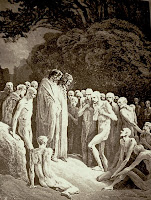 "A dark age began,
"A dark age began,a time of savagery of barbarism,
of book-burning, of superstition
and worship of empty idols.
The gentle Jesus was lost forever
in the image of a crucified God.
The Essene brothers hid their teachings in the minds of the few who could preserve them for their descendants, and the Scrolls of Healing lay neglected beneath the shifting shadows of the deserts." - the discovery of the Essene Gospel of Peace, by Edmond Bordeaux Szekely
1.
Earlier this month, while in Boulder, Colorado, I obtained a copy of The Essene Gospel of Peace (book one). Gnostic gospels have always attracted me, partly because the thirst of knowing Jesus and his mystic teachings were never quenched in the canonical gospels and they always felt incomplete. The Essene Gospel is particularly interesting because it strengthen and support the intuition and understanding (as well as scholarly, historical evidences) that Jesus was trained and raised as Nazarene Essene.
The Essene Gospels of Peace is quite unlike any other gnostic gospels I came across by the Will of God; its far more radical and sounds even more full of eastern and far eastern wisdom, yoga techniques including yogic breathing practices, teachings of tantrik vegetarianism and most strikingly the image of Feminine face of God (Earthly Mother, as its translated).
2. About the Recovery of Essene Gospel of Peace
The content of the first book represents about a third of the complete manuscripts which exist in Aramaic in the Secret Archive of the Vatican and in old Slavonic in the Royal Archives of the Habsburgs (Austria).
The existence of these two versions to the Nestorian priests who, under pressure of the advancing hordes of Genghis Khan, were forced to flee from the East towards the West, bearing all their ancient scriptures and ikons with them. The ancient Aramaic texts date from the 3rd century after Christ, while the old Slavonic version is a literal translation of the former. Exactly how the texts traveled from Palestine to the interior of Asia into the hands of the Nestorian priests, archaeologists are not yet able to reconstruct for sure.
 3. Essene Gospel of Peace starts in a gathering
3. Essene Gospel of Peace starts in a gatheringChrist says,
"I come because you need me."
It seems wandering Jesus went to visit a plague stricken community which might have been located remotely from the common population because of their untouchable diseases such as leprosy. Its important to note, because many of the teachings are possibly very specific for that very community suffering from terrible disease and wishes to be healed by this mystic master asking, "if you know all things, tell us, why do we suffer with these grievous plagues? ... Master, heal us, that we too may be made strong and need abide no longer in our misery..."
In the whole gospel thus the context is where Jesus is teaching everything which is useful for the healing of those sick and maimed, that offcourse contains universal aspect of it as well. As he explain his teachings, he also continues to physically heals many.
4. Yogic Food: Jesus recommended strongly Vegetarianism and Sattvik Food
In this particular community Jesus strongly talks about vegetarianism and explain in details how Thou Shall not Kill was initially meant and applied to all life, but later was compromised because the children of Israel couldn't respect the commandment in its truest format.
And Jesus continued: "God commanded your forefathers: 'Thou shalt not kill.' But their heart was hardened and they killed. Then Moses desired that at least they should not kill men, and he suffered them to kill beasts. And then the heart of your forefathers was hardened yet more, and they killed men and beasts likewise. But I do say to you : Kill neither men, nor beasts , nor yet the food which goes into your mouth. For if you eat living food, the same will quicken you, but if you kill your food, the dead food will kill you also. For life comes only from life, and from death comes always death.
" So eat always from the table of God: the fruits of the trees, the grains and grasses of the field, the milk of the beasts, and the honey of the bees. For everything beyond these is of Satan, and leads by the way of sins and of diseases unto death. But the food you eat from the abundant table of God give strength and youth to your body, and you will never see disease...."
The gospel goes on great detail on Jesus teachings which food to eat and what food are considered pure and even he describe the method of preparing their foods. What is very striking is his teaching is exactly same as what ancient yogis of India taught as Sattvik (or Sattvic) food.
In Indian sanskrit, Sattva is defined as the quality of purity and goodness. Sattvic food is that which is pure, clean and wholesome. Sattvik food provides the subtle nourishment necessary for vitality and consciousness. Food is seen as a carrier of the life force called prana and is judged by the quality of its Prana and by the effect it has on our consciousness. And the same teaching of ancient India is found very strongly in this particular gospel which again very much makes the scholarly claim and evidences that Christ did travel to India earlier in his life (and probably after surviving the crucifixion as well).
... "So eat always from the table of God: the fruits of the trees, the grain and grasses of the field, the milk of beasts and the honey of the bees ... the foods which you eat from the abundant table of God give strength and youth to your body, and you will never see disease ..."
 5. Yogic Breathing
5. Yogic BreathingTo this particular groups of audience, Jesus also teaches techniques that are exactly similar as ancient yogic breathing.
"Seek the fresh air of the forest and of the fields, and there in the midst of them shall you find the angel of air ... Then breath long and deeply, that the angel of air may be brought within you. I tell you truly, the angel of air shall cast out of your body all uncleannesses which defiled it without and within ..."
6. Teaching of Divine Remembrance with in Breath and out Breath
Jesus says, "Say the word, Light *, as you breath deeply of the angle of air, and you will become the Light itself; and the Holy Stream will carry you to the endless Kingdom of the Heavenly Father, there losing itself in the eternal Sea of Light which gives birth to all creation. And you shall be one with the Holy Stream of Light ..."
* In semitic root, Light is Nur, is also another Divine Name and in Sufi Remembrance practice it is used extensively. Quran says, "Allahu Nur-us samawati wal aard", God is the Light of Heaven and Earth.
And Christ continues, "Then breathe deeply of the angel of air, and say the word "Life"* with the outgiving of breath..."
* Again interesting to note in semitic language, (both ancient aramaic, langauge of Jesus and arabic) the word Life is Hayy; sound of breath expressed by the letter H. In Hebrew, one of these sacred names as YHWY, the Ever-Living Life.
While breathing out, saying Hayy is a practice which sufis still do in their zikr or Divine Remembrance, exactly what Christ was teaching as recorded in Essene Gospel of Peace.
7.
What is one the most extra ordinary aspect in the Essene Gospel of Peace is the idea of Earthly Mother or Divine Feminine which was never recorded (as far as i know) in other gospels. In the next post I would love to make some brief commentary on this. Since then, Peace be with you.
May YHWY's Eternal Peace be upon Jesus Christ and his blessed companions.
. The Essene Gospel of Peace
The Third Century Aramaic Manuscript and Old Slavonic Texts Compared, Edited and Translated by Edmond Bordeaux Szekely
The full text are available online from where you can read the Essene Gospel of Peace via Essene site.
. The Essene Gospel of Peace : Book 1
. The Unknown Books of the Essenes : Book2
. Lost Scrolls of the Essene Brotherhood : Book 3
. The Teachings of the Elect: Book 4
. The Sattvic or Yogic Diet
. Tantrik vegetarianism
. The Hidden Virtues of Food via Essene Spirit
. Vegetarianism and Spirituality
. Can Muslims be vegetarian?














COMMENTS